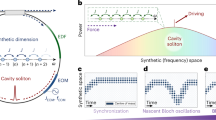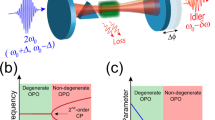Abstract
Taming the instabilities inherent to many nonlinear optical phenomena is of paramount importance for modern photonics. In particular, the so-called snake instability is universally known to severely distort localized wave stripes, leading to the occurrence of transient, short-lived dynamical states that eventually decay. This phenomenon is ubiquitous in nonlinear science—from river meandering to superfluids—and so far it apparently remains uncontrollable; however, here we show that optical snake instabilities can be harnessed by a process that leads to the formation of stationary and robust two-dimensional zigzag states. We find that such a new type of nonlinear waves exists in the hyperbolic regime of cylindrical microresonators, and that it naturally corresponds to two-dimensional frequency combs featuring spectral heterogeneity and intrinsic synchronization. We uncover the conditions of the existence of such spatiotemporal photonic snakes and confirm their remarkable robustness against perturbations. Our findings represent a new paradigm for frequency comb generation, thus opening the door to a whole range of applications in communications, metrology and spectroscopy.
This is a preview of subscription content, access via your institution
Access options
Access Nature and 54 other Nature Portfolio journals
Get Nature+, our best-value online-access subscription
$29.99 / 30 days
cancel any time
Subscribe to this journal
Receive 12 print issues and online access
$209.00 per year
only $17.42 per issue
Buy this article
- Purchase on Springer Link
- Instant access to full article PDF
Prices may be subject to local taxes which are calculated during checkout






Similar content being viewed by others
Data availability
The data that support the plots within this paper and other findings of this study are available from the corresponding author on reasonable request.
Code availability
The analysis codes will be made available on reasonable request.
References
Zakharov, V. E. & Rubenchik, A. M. Instability of waveguides and solitons in nonlinear media. Sov. Phys. JETP 38, 494–500 (1974).
Kuznetsov, E. A., Rubenchik, A. M. & Zakharov, V. E. Soliton stability in plasmas and hydrodynamics. Phys. Rep. 142, 103–65 (1986).
Kivshar, Y. S. & Pelinovsky, D. E. Self-focusing and transverse instabilities of solitary waves. Phys. Rep. 331, 117–195 (2000).
Constantin, J. A., Dunne, T., Ahmed, J., Legleiter, C. & Lazarus, E. D. Sediment supply as a driver of river meandering and floodplain evolution in the Amazon Basin. Nat. Geosci. 7, 899–903 (2014).
Brown, E. D. et al. Observations of a nonlinear solitary wave packet in the Kelvin wake of a ship. J. Fluid Mech. 204, 263–293 (1989).
Yefsah, T. et al. Heavy solitons in a fermionic superfluid. Nature 499, 426–430 (2013).
Cetoli, A., Brand, J., Scott, R. G., Dalfovo, F. & Pitaevskii, L. P. Snake instability of dark solitons in fermionic superfluids. Phys. Rev. A 88, 043639 (2013).
Claude, F. et al. Taming the snake instabilities in a polariton superfluid. Optica 7, 1660–1665 (2020).
Anderson, B. P. et al. Watching dark solitons decay into vortex rings in a Bose–Einstein condensate. Phys. Rev. Lett. 86, 2926–2929 (2001).
Luengviriya, C. et al. Scroll wave instabilities in an excitable chemical medium. Phys. Rev. Lett. 100, 148302 (2008).
Mamaev, A. V., Saffman, M. & Zozulya, A. A. Propagation of dark stripe beams in nonlinear media: snake instability and creation of optical vortices. Phys. Rev. Lett. 76, 2262–2265 (1996).
Tikhonenko, V., Christou, J., Luther-Davies, B. & Kivshar, Y. S. Observation of vortex solitons created by the instability of dark soliton stripes. Opt. Lett. 21, 1129–1131 (1996).
Gorza, S.-P., Roig, N., Emplit, P. & Haelterman, M. Snake instability of a spatiotemporal bright soliton stripe. Phys. Rev. Lett. 92, 084101 (2004).
Gorza, S.-P., Deconinck, B., Emplit, P., Trogdon, T. & Haelterman, M. Experimental demonstration of the oscillatory snake instability of the bright soliton of the (2 + 1)D hyperbolic nonlinear Schrödinger equation. Phys. Rev. Lett. 106, 094101 (2011).
Gorza, S.-P., Emplit, P. & Haelterman, M. Observation of the snake instability of a spatially extended temporal bright soliton. Opt. Lett. 31, 1280–1282 (2006).
Brasch, V. et al. Photonic chip-based optical frequency comb using soliton Cherenkov radiation. Science 351, 357–360 (2016).
Yi, X. et al. Single-mode dispersive waves and soliton microcomb dynamics. Nat. Commun. 8, 14869 (2017).
Karpov, M. et al. Raman self-frequency shift of dissipative Kerr solitons in an optical microresonator. Phys. Rev. Lett. 116, 103902 (2016).
Yang, Q.-F., Yi, X., Yang, K. Y. & Vahala, K. Stokes solitons in optical microcavities. Nat. Phys. 13, 53–57 (2017).
Yu, M. et al. Raman lasing and soliton mode-locking in lithium niobate microresonators. Light: Sci. Appl. 9, 9 (2020).
Stone, J. R. et al. Thermal and nonlinear dissipative-soliton dynamics in Kerr-microresonator frequency combs. Phys. Rev. Lett. 121, 063902 (2018).
Obrzud, E., Lacomte, S. & Herr, T. Temporal solitons in microresonators driven by optical pulses. Nat. Photon. 11, 600–607 (2017).
Pasquazi, A. et al. Micro-combs: a novel generation of optical sources. Phys. Rep. 729, 1–81 (2017).
Cundiff, S. T. & Ye, J. Colloquium: Femtosecond optical frequency combs. Rev. Mod. Phys. 75, 325–342 (2003).
Yang, Q. F., Yi, X., Yang, K. Y. & Vahala, K. Counter-propagating solitons in microresonators. Nat. Photon. 11, 560–564 (2017).
Weng, W., Bouchand, R., Lucas, E. & Kippenberg, T. J. Polychromatic Cherenkov radiation induced group velocity symmetry breaking in counterpropagating dissipative Kerr solitons. Phys. Rev. Lett. 123, 253902 (2019).
Tikan, A. et al. Emergent nonlinear phenomena in a driven dissipative photonic dimer. Nat. Phys. 17, 604–610 (2021).
Jang, J. K. et al. Observation of Arnold Tongues in Coupled Soliton Kerr Frequency Combs. Phys. Rev. Lett. 123, 153901 (2019).
Lucas, E. et al. Spatial multiplexing of soliton microcombs. Nat. Photon. 12, 699–705 (2018).
Lugiato, L. A. & Lefever, R. Spatial dissipative structures in passive optical systems. Phys. Rev. Lett. 58, 2209–2211 (1987).
Conti, C. et al. Nonlinear electromagnetic X waves. Phys. Rev. Lett. 90, 170406 (2003).
Di Trapani, P. et al. Spontaneously generated X-shaped light bullets. Phys. Rev. Lett. 91, 093904 (2003).
Cisneros-Ake, L. A., Carretero-González, R., Kevrekidis, P. B. & Malomed, B. A. Dynamics and stabilization of bright soliton stripes in the hyperbolic-dispersion nonlinear Schrödinger equation. Commun. Nonlinear Sci. Numer. Simul. 74, 268–281 (2019).
Barashenkov, I. & Smirnov, Y. S. Existence and stability chart for the ac-driven, damped nonlinear Schrödinger solitons. Phys. Rev. E 54, 5707–5725 (1996).
Mc Laughlin, D. W., Moloney, J. V. & Newell, A. C. Solitary Waves as Fixed Points of Infinite-Dimensional Maps in an Optical Bistable Ring Cavity. Phys. Rev. Lett. 51, 75–78 (1983).
Pelinovsky, D. E., Kivshar, Y. S. & Afanasjev, V. V. Internal modes of envelope solitons. Physica D 116, 121–142 (1998).
Skryabin, D. V. & Firth, W. J. Modulational instability of solitary waves in non-degenerate three wave mixing: the role of phase symmetries. Phys. Rev. Lett. 81, 3379–3382 (1998).
Brazhnyi, V. A. & Pérez-García, V. M. Stable multidimensional soliton stripes in two-component Bose-Einstein condensates. Chaos Solit. Fractals 44, 381–389 (2011).
Parra-Rivas, P., Knobloch, E., Gomila, D. & Gelens, L. Dark solitons in the Lugiato-Lefever equation with normal dispersion. Phys. Rev. A 93, 063839 (2016).
Godey, C., Balakireva, I. V., Coillet, A. & Chembo, Y. K. Stability analysis of the spatiotemporal Lugiato-Lefever model for Kerr optical frequency combs in the anomalous and normal dispersion regimes. Phys. Rev. A, 89, 063814 (2014).
Picqué, N. & Hänsch, T. W. Frequency comb spectroscopy. Nat. Photon. 13, 146–157 (2019).
Demchenko, Y. A. & Gorodetsky, M. L. Analytical estimayes of eigenfrequencies, dispersion, and field distribution in whispering gallery resonators. J. Opt. Soc. Am. B 30, 3056–3063 (2013).
Milián, C., Kartashov, Y. V., Skryabin, D. V. & Torner, L. Clusters of cavity solitons bounded by conical radiation. Phys. Rev. Lett. 121, 103903 (2018).
Hamidfar, T. et al. Localisation of light in an optical microcapillary induced by a droplet. Optica 5, 382–388 (2018).
Ilchenko, V. S. & Gorodetskii, M. L. Thermal nonlinear effects in optical whispering gallery microresonators. Laser Phys. 2, 1004–1009 (1992).
Leshem, A., Qi, Z., Carruthers, T. F., Menyuk, C. R. & Gat, O. Thermal instabilities, frequency-comb formation, and temporal oscillations in Kerr microresonators. Phys. Rev. A 103, 013512 (2021).
Savchenkov, A. A. et al. Kerr frequency comb generation in overmoded resonators. Opt. Express 20, 27290–27298 (2012).
Xue, X. et al. Mode-locked dark pulse Kerr combs in normal-dispersion microresonators. Nat. Photon. 9, 594–600 (2015).
Jang, J. K. et al. Dynamics of mode-coupling-induced microresonator frequency combs in normal dispersion. Opt. Express 24, 28794–28803 (2016).
Nazemosadat, E. et al. Switching dynamics of dark-pulse Kerr frequency comb states in optical microresonators. Phys. Rev. A 103, 013513 (2021).
Xue, X. et al. Normal-dispersion microcombs enabled by controllable mode interactions. Laser Photon. Rev. 9, L23–L28 (2015).
Kim, B. Y. et al. Turn-key, high-efciency Kerr comb source. Opt. Lett. 44, 4475–4478 (2019).
Jin, W. et al. Hertz-linewidth semiconductor lasers using CMOS-ready ultra-high-Q microresonators. Nat. Photon. 15, 346–353 (2021).
Shen, B. et al. Integrated turnkey soliton microcombs. Nature 582, 365–369 (2020).
Rowley, M. et al. Self-emergence of robust solitons in a microcavity. Nature 608, 303–309 (2022).
Nie, M. et al. Dissipative soliton generation and real-time dynamics in microresonator-filtered fiber lasers. Light Sci. Appl. 11, 296 (2022).
Weng, W. et al. Heteronuclear soliton molecules in optical microresonators. Nat. Commun. 11, 2402 (2020).
Jang, J. K. et al. Synchronization of coupled optical microresonators. Nat. Photon. 12, 688–693 (2018).
Cheo, P. K. & Wagner, R. Infrared Electrooptic Waveguides. IEEE J. Quantum Electron. 13, 159–164 (1977).
Deuflhard, P. Newton Methods for Nonlinear Problems: Affine Invariance and Adaptive Algorithms Vol. 35 (Springer, 2004).
Acknowledgements
J.A.C. and C.M. acknowledge support from the Spanish government via grant PID2021-124618NB-C21, which was funded by MCIN/AEI/10.13039/501100011033 and ‘ERDF: a way of making Europe’ of the European Union. C.M. acknowledges support from Generalitat Valenciana PROMETEO/2021/082. P.F.d.C. acknowledges partial support from the Spanish government via project PID2021-128676OB-I00 (MICINN). L.T. acknowledges support by CEX2019-000910-S (MCIN/AEI/10.13039/501100011033), F. Cellex, F. M. Puig and Generalitat de Catalunya (CERCA). Y.V.K.’s academic research has been supported by the research project FFUU-2021-0003 of the Institute of Spectroscopy of the Russian Academy of Sciences.
Author information
Authors and Affiliations
Contributions
S.B.I. and C.M. performed numerical simulations. C.M. conceived the project. All of the authors substantially contributed to this work, discussed the results, and contributed to the preparation of the manuscript.
Corresponding author
Ethics declarations
Competing interests
The authors declare no competing interests.
Peer review
Peer review information
Nature Photonics thanks Stefan Wabnitz and the other, anonymous, reviewer(s) for their contribution to the peer review of this work.
Additional information
Publisher’s note Springer Nature remains neutral with regard to jurisdictional claims in published maps and institutional affiliations.
Supplementary information
Supplementary Information
Supplementary Figs. 1–7, Sections 1–8 and references.
Rights and permissions
Springer Nature or its licensor (e.g. a society or other partner) holds exclusive rights to this article under a publishing agreement with the author(s) or other rightsholder(s); author self-archiving of the accepted manuscript version of this article is solely governed by the terms of such publishing agreement and applicable law.
About this article
Cite this article
Ivars, S.B., Kartashov, Y.V., de Córdoba, P.F. et al. Photonic snake states in two-dimensional frequency combs. Nat. Photon. 17, 767–774 (2023). https://doi.org/10.1038/s41566-023-01220-1
Received:
Accepted:
Published:
Issue Date:
DOI: https://doi.org/10.1038/s41566-023-01220-1
This article is cited by
-
Nonlinear dynamics and Kerr frequency comb formation in lattices of coupled microresonators
Communications Physics (2023)



